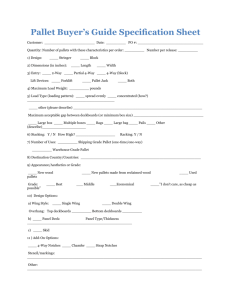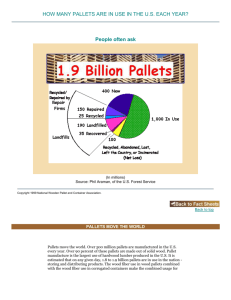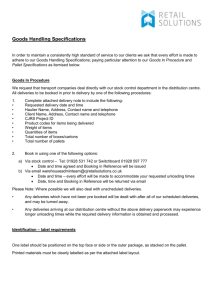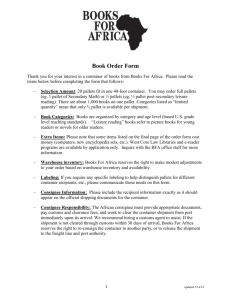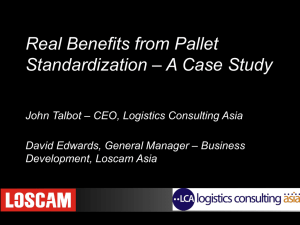FORKLIFT ROUTING IN WAREHOUSES USING DUAL- COMMANDS AND STACKABLE PALLETS Ahmed Hassan
advertisement
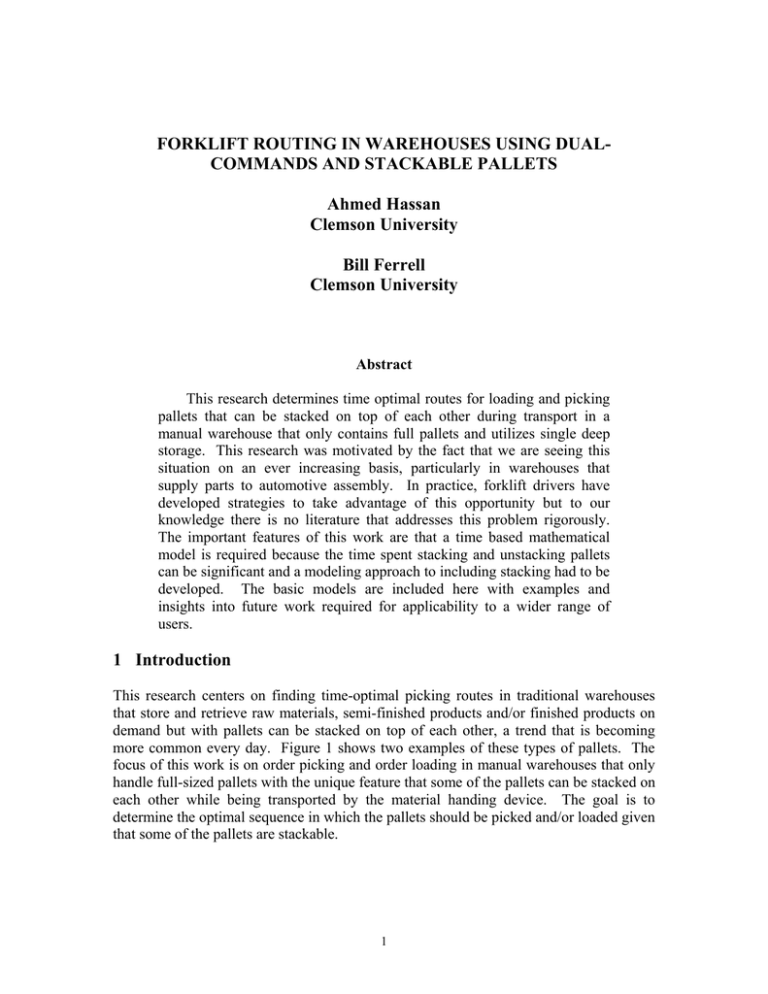
FORKLIFT ROUTING IN WAREHOUSES USING DUALCOMMANDS AND STACKABLE PALLETS
Ahmed Hassan
Clemson University
Bill Ferrell
Clemson University
Abstract
This research determines time optimal routes for loading and picking
pallets that can be stacked on top of each other during transport in a
manual warehouse that only contains full pallets and utilizes single deep
storage. This research was motivated by the fact that we are seeing this
situation on an ever increasing basis, particularly in warehouses that
supply parts to automotive assembly. In practice, forklift drivers have
developed strategies to take advantage of this opportunity but to our
knowledge there is no literature that addresses this problem rigorously.
The important features of this work are that a time based mathematical
model is required because the time spent stacking and unstacking pallets
can be significant and a modeling approach to including stacking had to be
developed. The basic models are included here with examples and
insights into future work required for applicability to a wider range of
users.
1 Introduction
This research centers on finding time-optimal picking routes in traditional warehouses
that store and retrieve raw materials, semi-finished products and/or finished products on
demand but with pallets can be stacked on top of each other, a trend that is becoming
more common every day. Figure 1 shows two examples of these types of pallets. The
focus of this work is on order picking and order loading in manual warehouses that only
handle full-sized pallets with the unique feature that some of the pallets can be stacked on
each other while being transported by the material handing device. The goal is to
determine the optimal sequence in which the pallets should be picked and/or loaded given
that some of the pallets are stackable.
1
Figure 1: Two types of stackable pallets
Obviously, determining pick paths is not a new problem; however, having stackable
pallets introduces some unique challenges in determining the optimal paths. The most
fundamental is that the objective function must be time based and not distance based
because there are a number of maneuvers associated with stacking and unstacking that
can impact the series of routes yielding the maximum work performed in a day. For
example, consider the loading process where a forklift must stack the pallets at the depot,
move them to the first location, sit them down in the aisle, unstack them, pick up the one
to be placed in the rack, place it, pick up the second pallet and then proceed to load it in
the correct location. (This paper will henceforth refer to the material handling device
used in the warehouse as a forklift.) Stacking all pallets can actually be rather inefficient
– consider the situation in which all storage locations are very near the depot. With
single deep storage, it is easy to visualize that storing these pallets individually could
save a reasonable amount of time over the stacking and unstacking process given short
travel distances. As such, this research uses mathematical programming with a timebased model to determine routes and the model explicitly includes times associated with
the maneuvers required to stack and unstack the pallets.
2 Relevant Literature
The literature in this general research area is quite extensive so only a few key papers that
are most directly related to this research are referenced here.
2.1 Distance-based approaches
Although this work is focused on a time-based model, it is important to briefly
acknowledge the tremendous contributions made by a number of researchers in picking
operations using distance based optimization. Ratliff and Rosenthal [1] provided an early
2
contribution that addresses the order picking problem in a rectangular warehouse that
contains crossovers only at the ends of aisles. This idea was extended in very interesting
and practical ways by De Koster and Van der Poort [2] and Roodbergen and De Koster
[3]. Since then, other research has been conducted including treating picking as a
traveling salesman problem and using heuristic approaches to find good solutions [4] and,
as might be expected, using metaheuristics [5].
2.2 Time-based approaches
Research has also been conducted on pick operations that are time based, although the
purpose has never been to develop optimal sequences. Le-Duc and DeKoster [6] estimate
the expected travel time using mathematical programming while Chew and Tang [7] use
expected travel time to investigate order batching and storage allocation strategies. Yu
and De Koster [8] analyze the impact of order batching and picking area zoning on the
mean throughput time in an a pick-and-pass order picking system. Finally, Parikh and
Meller [9] develop an expected travel time model for a person-onboard order picking
system to determine the optimal storage system configuration such as the height of the
storage aisles.
2.3 Dual command
The general idea of a material handling device receiving a command for a pick while in
the process of storing an item is called dual command and has been applied to automated
storage and retrieval systems dating back to at least 1991 [10]. The literature seems
completely focused on dual commands in these types of systems until Pohl and Meller
[11] develop an expression for expected travel distance in warehouses being controlled
by dual command.
In conclusion, picking and loading problems are important elements of warehouse
operations and have been studied for years as a result. Distance based models are
common for determining optimal pick sequences and graph theory is a commonly used
foundation. Time based models have appeared over the past few years but these focus on
travel time or throughput. Dual command research has centered on automated storage and
retrieval systems. The research in this paper is related to the prior contributions but is
quite unique because we consider pallets that are stackable and use a time-based
mathematical programming approach to find optimal routings.
3 Single Function (Pick or Store) Models
Hassan and Ferrell [12] developed a method to include the ability for pallets to be stacked
(henceforth, referred to as “stackability”) using a Boolean programming, distance based
model. The model found the minimum time pick paths for a manual warehouse when no
3
more than two pallets could be stacked but this model did not include any time elements
associated with pallet maneuvering. Figure 2 illustrates an example of this order picking
process. A forklift starts from the depot (1), picks a pallet at 3 (passing by point 2) and
then picks a second pallet at 4 and stacks it on the pallet that was picked at 3. The
Figure 2: Example route for a warehouse with one cross aisle
forklift then returns to the depot at point 5 with the two stacked pallets. Stackability is
accomplished through a matrix that identifies the pallets that can be stacked on each
other. If there are n pallets to be picked, the stackability matrix is simply an n x n matrix
where element (i, j) equals 1 if pallet i is stackable on pallet j and 0 otherwise. This
matrix is a user input and reflects any restrictions so the matrix does not have to be
symmetric across the diagonal. Hence, it is easy to allow pallet A to be stacked on B but
not vice versa if, for example, B is heavy and A is quite light so stacking B on A would
create stability problems. Since the time associated with maneuvering the pallets can
consume a significant fraction of a route’s duration, a time-based model was developed.
3.1 Time-based Model
The time-based model [13] that determines the optimal route for either loading n pallets
or picking n pallets is fundamentally the same with the only difference in the
interpretation of a few parameters and variables. The model is described for the picking
function and, afterwards, the modified interpretation for loading is described. The
assumptions upon which the model is based are:
4
•
•
All routes begin and end at the depot.
Fixed storage is used and there is a one-to-one mapping between locations and
pallets.
• Whether i is stackable on j or vice versa, the stacking can be accomplished at either
location.
• A maximum of two pallets may be stacked.
Locations in the warehouse are numbered as follows: the depot is location 1, the n pallets
are locations 2 through n+1 and there is a dummy node at location n+2. The dummy
node is a technical necessary that is connected to all locations and travel time is zero.
The model utilizes the parameters and variables identified below.
Input parameters
• Sij = 1 if pallet i is stackable on j; 0 otherwise
• τij = the time it takes the forklift to travel between pallet i and pallet j in minutes (We
assume a constant speed forklift so this is simply distance/speed.)
• tp = time required to pick a pallet from the rack in minutes
• ts = time to stack one pallet on another in minutes
Decision variables
• Xij = 1 if the path includes moving from node i to node j; 0 otherwise
• Yi = 1 if pallet i is picked; 0 otherwise
• Zij = 1 if pallet i is stacked on top of pallet j; 0 otherwise
• RDi = 1 if you return from pallet i to Depot; 0 otherwise
Model
n+1
n+1
n+1 n+1
n+1 n+1
n+1 n+1
n+1
k =2
k =2
k =2 l =2
k =2 l =2
k =2 l =2
k =2
Min z = ∑ τ1k *Yk + ∑ t p *Yk + ∑ ∑τ kl * Z kl + ∑ ∑ t p * Z kl + ∑ ∑ t s * Z kl + ∑ τ k1 * RDk
Subject to
∑
n+2
i =2
X 1i ≥ 1
(1)
X ij + X ji ≤ Sij + S ji
i,j = 2, 3… n+2
(2)
∑
j = 2, 3… n+2
(3)
n+2
i =1
X ji ≥ X 1 j
X n + 2,1 = X 1,n + 2
X j1 ≥ ∑ i = 2 X ij
n+2
∑
∑
n+2
i =1
n+2
i =1
(4)
j = 2, 3… n+2
(5)
X ij = 1
j = 2, 3… n+2
(6)
X ji = 1
j = 2, 3… n+2
(7)
5
∑
n+2
i =1
X ii = 0
(8)
X ij + X ji ≤ 1
i,j = 2, 3… n+2
(9)
Yit = X 1i
Z ij = X ij
i =2, 3 … n+1
(10)
i =2, 3 … n+1
(11)
RDi = X i1
X ij = {0, 1}
i =2, 3 … n+1
i,j = 2, 3… n+2
(12)
(13)
The objective function consists of travel time plus times to manipulate the pallets. The
constraints in the model perform the functions indicated below.
1) Requires the first segment of a route to be from the depot to a pallet
2) Enforces the stackability inputs by setting Xij=0 if Sij=0
3) Requires the second segment of a route is either to a second pallet so that stacking can
occur or back to depot
4) Forces immediate return to depot after visiting the dummy node (n+2)
5) Forces each route to return to the depot after completing a double stack or a single
pick
6) Ensures that each pallet is picked once
7) Preserves feasibility by forcing each route to leave a node only once
8) Prevents stacking pallets on themselves
9) Eliminates cycles by requiring that the trip between any two pallets is made only once
10) Sets Yi to one when the path is from depot to pallet i. Y is needed to identify the time
element of picking the first pallet in the objective function.
11) Sets Zij equal to one when a path in the optimal routing includes picking pallet i and
then j so the time to pick the second pallet is included in the objective function.
12) Sets RDi equal to one when the path returns from pallet i to depot so the return time is
included in the objective function.
3.2 Time-based loading model
The model presented in 3.1 determines the optimal loading sequence for n pallets using
fixed storage if a few variables and parameters are interpreted a differently.
tp = time to load one pallet from a double stacked pallets setup on a rack in minutes
ts = time to load a single pallet on a rack in minutes
Yi = 1 if pallet i is chosen to be loaded; 0 otherwise
3.3. Numerical Results
A number of numerical examples were performed to validate and verify the model as
well as illustrate features. The number of pallets to be picked or loaded ranges from 5 to
250. The values used for the input parameters are documented in [14] and are consistent
with our experience. The travel times between all pairs of locations was computed by
first identifying the locations on a layout similar to Figure 2 and determining the
6
rectilinear distances. Travel times were determined by assuming a forklift travel speed of
150 feet per minute. This reference [14] also suggested tp =0.3 min and ts=0.3. All of the
numerical examples were solved to optimality using ILOG OPL Development Studio
version 5.5 and a Dell personal computer with an Intel Core 2 Duo processor and 2.00
GB of RAM.
Several smaller examples were tested in which the optimal solution could be
determined by complete enumeration to verify the model was executing correctly. An
example with 100 pallets to be loaded was devised so that consecutively numbered
pallets had contiguous locations and were stackable. The optimal pick path stacked the
pairs of pallets at distant locations to avoid two single trips for the depot to the location.
Pair of pallets that could be stacked but had storage locations near the depot were stored
singly with a return to the depot between each. This was expected and served as further
verification that the time based approach was correctly implemented. It is worth noting
that, in this example, the time associated with the optimal solution was 268.13 minutes, a
significant savings over the time it would take to store each pallet singly which is 423.33
minutes. From a practical viewpoint, these saving could provide a cost justification for
the purchase and use of at least some stackable pallets in a high volume warehouse.
The impact that increasing the number of pallets to be loaded or picked has on the
time to find the optimal solution was anecdotally investigated with the same basic model
parameters described above. The model was solved for several numbers of pallets and
the computation times are displayed in Figure 3. The density of the stackability matrix
was kept constant by setting the number of “1’s” in the matrix equal to the number of
Figure 3: Solution time vs. Problem size
7
pallets in the problem. That is, if the problem has n pallets, then there are n × n possible
pairs of pallets that could be stacked on each other. For these experiments, n of these
were selected. This result is expected due to the combinatorial nature of the underlying
problem.
The impact that increasing the “density” of the stackability matrix has on the time
required to find the optimal solution is now explored. This is a common idea in many
areas including flow dominance originally introduced by Vollmann and Buffa [15]. To
illustrate, a 250 pallet problem is used and computation time plotted versus the number of
potential pairs that can be stacked. The results are seen in Figure 4. The general trend
Figure 4: Solution time vs. Stackability density in a 250 pallet
suggests that the solution time is relatively insensitive to the stackability density. This
results also appeals to our intuition because increasing the density increases the size of
some constraints but not the number or the number so it is not a combinatorial explosion.
The increase would likely be more prominent for larger problems but this one example
suggests the increase is polynomial at worst. Formalizing this result is under
investigation.
4 Pick and Store Model
Sometimes, forklift operators have the responsibility for both picking and storing in the
same route. We have seen this used in a smaller distribution centers as the primary mode
of handling inventory and in larger ones as one mode along with other forklifts dedicated
to picking and others to storing. Even though this change does not seem terribly different
from single function operation, the model is significantly different. Decomposing a trip
8
reveals that the forklift driver would leave the depot with zero, one or two pallets to store.
The first move could either be a store or a pick if only one pallet were originally loaded at
the depot. Correctly modeling all of the options along with accurately tracking the
appropriate times for pallet manipulation creates a dramatically larger and more complex
model.
The modeling strategy currently being adopted to address this situation uses an
objective function that enumerates all possible combinations of moves that can occur
after the initial move from the depot to a location and before the last move back to the
depot. In general, the constraints control the permissible moves in the same spirit as in
the single function model but with dramatically different details. The model is nonlinear
but for computation examples, OPL has some special features that allow it to still be used
although the combinatorial explosion is realized at a much smaller number of pallets
5 References
[1] H.D. Ratliff, H.D and Rosenthal, A.S., “Order-picking in a rectangular warehouse: A
solvable case of the traveling salesman problem,” Operations Research, 31, 507–521
(1983).
[2] R. De Koster, R and Van der Poort, E.S., “Routing order pickers in a warehouse: A
comparison between optimal and heuristic solutions,” IIE Transactions, 30, 469–480
(1998) .
[3] K.J. Roodbergen, K.J and De Koster, R., “Routing methods for warehouses with
multiple cross aisles,” International Journal of Production Research, 39, 1865–1883
(2001).
[4] Theys, C., Braysy, O., Dullaert, W., et al., “Using a TSP heuristic for routing order
pickers in warehouses, European Journal of Operational Research, 200, 3, 755-763
[5] Tsai, C.Y., Liou, J.J.H. and Huang, T.M. “Using a multiple-GA method to solve the
batch picking problem: considering travel distance and order due time,” International
Journal of Production Research, 46, 22, 6533-6555 (2008).
[6] Le-Duc, T. and De Koster, R., “Travel time estimation and order batching in a 2block warehouse,” European Journal of Operational Research, 176, 374-388 (2007).
[7] Chew, E.P and Tang, L.C., “Travel time analysis for general item location assignment
in a rectangular warehouse,” European Journal of Operational Research, 112, 582597 (1999).
[8] Yu, M. and De Koster, R., “The impact of order batching and picking area zoning
9
on order picking system performance,” European Journal of Operational Research,
198, 2, 480-490 (2009).
[9] Parikh, P and Meller, R., “A Travel-Time Model for a Person-Onboard Order
Picking System,” European Journal of Operational Research, 200, 2, 385-394
(2010).
[10] Foley, R.D. and Frazelle, E.H, “Analytical results for miniload throughput and the
distribution of dual command travel time,” IIE Transactions, 23, 3, 273-281 (1991).
[11] Pohl, L.M and Meller, R.D., “An Analysis of Dual-Command Operations in
Common Warehouse Designs,” Transportation Research Part E-Logistics and
Transportation Review. 45, 3, 367-379 (2009).
[12] Hassan Aly, A and Ferrell, W., “Order-picking path optimization with multiple
picks per route using pallet stackability concept in a warehouse,” Proceedings of the
Industrial Engineering Research Conference (2009).
[13] Hassan Aly, A. and Ferrell, W., “Order picking and loading with stackable pallets,”
Journal of Manufacturing Systems, under review.
[14] Petersen, C.G and Aase, G., “A comparison of picking, storage, and routing policies
in manual order picking,” International Journal of Production Economics, 92, 11-19
(2004).
[15] Vollmann, T. and Buffa, E. “The Facilities Layout Problem in Perspective,”
Management Science, 12, 450-468 (1966).
10
